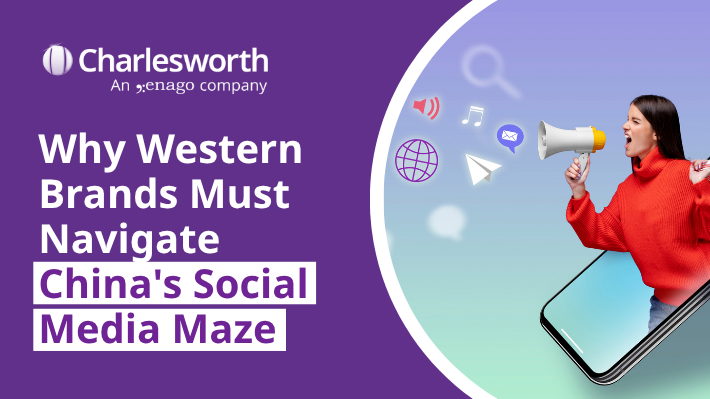Why Understanding the Social Media Maze is Crucial for Western Brands Entering China

As one of the world’s largest and fastest-growing consumer markets, China has become a land of opportunity for Western brands. But breaking into this market is far from straightforward. Despite the vast potential, many iconic brands have stumbled, often due to fundamental misunderstandings of local consumer behaviour, cultural differences, and the unique digital landscape. In particular, social media and e-commerce are two major areas where Western brands either succeed or fail in China.
In this blog, we’ll explore how some Western brands have adapted their digital strategies to leverage China’s social media platforms, examining the missteps of those that didn’t adjust, as well as the success stories of those that understood and embraced the nuances of Chinese digital marketing.
The Challenges of China’s Digital Ecosystem
Unlike Western markets where platforms like Facebook, Google, and Instagram dominate, China’s internet is governed by its own ecosystem. The country has its own social media platforms, search engines, and e-commerce giants—most notably WeChat, Weibo, Baidu, and Alibaba’s Taobao. This digital divide is one of the biggest obstacles for Western brands attempting to enter the Chinese market.
For instance, WeChat’s all-in-one functionality means that users spend a significant amount of time within the app, making it a prime location for brands to engage with consumers through multiple touchpoints.
A key difference between Western and Chinese social media is the importance of integration and multifaceted platforms. For example, WeChat is not just a messaging app—it’s a super app that includes e-commerce, payments, social media, and news. For brands, this means that a simple social media strategy doesn’t cut it. They need to engage across multiple channels on the same platform to effectively capture Chinese audiences.
This multifaceted approach requires brands to think holistically about their presence on platforms like WeChat, considering how different features can work together to enhance the customer journey.
Missteps in the Digital Approach
One major reason Western brands fail in China is their attempt to transplant Western digital strategies without adapting to local realities. A classic example is eBay. In the early 2000s, eBay entered China with its Western business model intact, focused on online auctions. However, it failed to acknowledge the Chinese consumer’s preference for a fixed-price marketplace and the importance of local relationships in buying behaviour. eBay’s strategy overlooked the cultural preference for bargaining and the need for visible trust signals in transactions, which are more readily provided by platforms like Taobao.
Competing platform Taobao—a subsidiary of Alibaba—understood these local needs. It allowed buyers and sellers to communicate directly, building personal trust and offering a more relevant experience. In the end, eBay’s failure to localise its approach saw it lose out to Taobao, which today remains the dominant player in China’s e-commerce space.
Similarly, Google’s attempt to enter the Chinese market was stifled by its failure to recognise the importance of local regulations and search engine preferences. Baidu, the dominant Chinese search engine, had a deeper understanding of local language nuances and the Chinese government’s requirements, giving it an edge over Google, which eventually withdrew from China. Baidu’s adaptation to local language nuances allowed it to provide more relevant search results, aligning with how Chinese users naturally framed their queries.
Learning from the Success Stories
While many Western brands have faltered, there are notable examples of those who have cracked the code to China’s digital marketing landscape. These brands succeeded by understanding how Chinese consumers interact with technology, social media, and digital content.
1. Starbucks: Mastering WeChat and E-Commerce Integration
Starbucks offers a textbook example of how to use social media platforms to drive brand loyalty in China. The coffee giant launched its digital strategy around WeChat, a platform that dominates Chinese digital interactions. Starbucks not only created an official WeChat account but also integrated it with a seamless e-commerce experience, allowing users to order and pay for their coffee directly through the app.
Additionally, Starbucks collaborated with WeChat Pay to offer cashless payments, catering to the tech-savvy Chinese consumer who values convenience. Starbucks also uses WeChat to engage with customers through loyalty programmes, offering rewards and exclusive promotions. Through these adaptations, Starbucks has positioned itself as an aspirational lifestyle brand in China, successfully appealing to both urban professionals and younger consumers.
2. Nike: Embracing Local Influencers and Digital Content
Nike’s digital marketing strategy in China has been a masterclass in blending global branding with localised content. Nike understood that Chinese consumers are not only influenced by traditional advertising but are also highly impacted by social media influencers and content creators. As a result, Nike collaborated with local influencers and KOLs (Key Opinion Leaders) to promote its products and create engaging content.
Nike also launched interactive campaigns tailored specifically to the Chinese audience. One notable initiative was the Nike Training Club app, which connected with China’s growing fitness culture. Through targeted content and the use of popular Chinese digital platforms, Nike was able to connect with consumers on a more personal level. By aligning with Chinese values such as self-improvement, health, and status, Nike strengthened its position as a leader in sportswear.
3. L’Oréal: Integrating E-Commerce with Social Media Platforms
Beauty giant L’Oréal was another Western brand that capitalised on China’s unique digital environment. The brand used Weibo and WeChat to engage with young, digitally-savvy Chinese consumers while also tapping into live-streaming platforms like Douyin (the Chinese equivalent of TikTok) to drive product awareness and sales. These platforms are pivotal in China, where consumers prefer to make purchase decisions based on influencer reviews and live-streamed demonstrations.
L’Oréal’s success is also due to its integration with Alibaba’s Tmall and JD.com for e-commerce. By partnering with these platforms, L’Oréal ensured that it was directly in front of Chinese consumers when they were ready to make a purchase, capitalising on the e-commerce boom and facilitating a smooth buying process.
The Power of Localisation
The key takeaway from these success stories is the importance of localisation—not just in terms of language, but in understanding the unique behaviours, preferences, and trends of Chinese consumers. Successful brands adapt their digital strategies to local platforms, work with influencers who resonate with Chinese audiences, and optimise their offerings for mobile-first, e-commerce-driven behaviours. Localization also involves understanding regional differences within China, as consumer preferences can vary significantly between cities and provinces.
WeChat, Weibo, and Douyin are more than just platforms; they are the gateways to reaching a vast and diverse audience. Brands that succeed understand that digital marketing in China is not just about having a presence on these platforms but about creating experiences that speak directly to the desires and values of Chinese consumers.
Conclusion: Adaptability is Key
While Western brands face significant challenges when entering China, those that succeed are those who approach the market with an open mind and a willingness to adapt. Digital platforms in China are not simply tools for promotion—they are central to consumer interactions, making it crucial for brands to deeply understand and leverage these platforms. By working with local influencers, adapting content to Chinese cultural nuances, and embracing e-commerce and mobile payment systems, Western brands can not only survive but thrive in one of the world’s most exciting markets.
If you’re looking to understand how your brand can unlock the potential of the Chinese market and navigate the complexities of local social media, Charlesworth can help. With years of experience in digital marketing and a deep understanding of Chinese consumer behaviours, we can help you craft a tailored strategy that speaks directly to your target audience. From navigating platforms like WeChat and Weibo to leveraging influencers and integrating e-commerce, Charlesworth is here to guide your brand toward success in China’s dynamic digital landscape. Get in touch with us today to learn how we can help you grow in the world’s largest consumer market.


